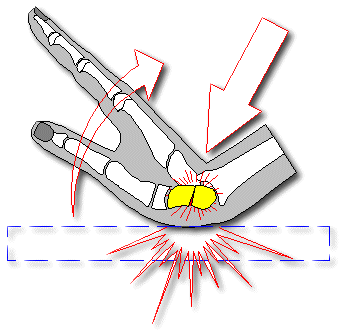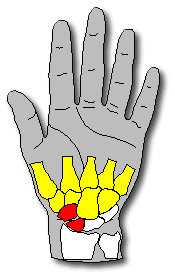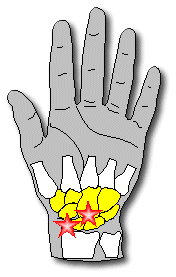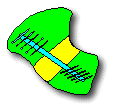| What is it? |
-
When someone breaks their wrist, they may break any of a number of bones.
-
The most common types of wrist fractures are those involving one of the
wrist bones, such as the scaphoid bone, and those involving a break of
the end of the forearm bones.
-
A Colles fracture is a wrist fracture involving
a break of the end of the radius bone of the forearm ("distal radius fracture").
|
| What caused it? |
| Wrist fractures occur most often in a fall or in a motor vehicle accident,
but any sufficiently strong force on the hand can break the wrist. The
wrist can be broken from a sudden force pushing the hand backwards. |
|
 |
 |
| Scaphoid fractures are known to have unpredictable healing. This is
due to the unique anatomy of the scaphoid itself. The fracture often cuts
off normal blood circulation to pieces of the bone. Also, one set of wrist
bones (yellow) attached to one end of the bone pull in different directions
than others (white) attached to the other end of the bone, pulling so strongly
that it may not be possible to hold them together with any type of cast.
For this reason, these fractures may heal slowly (delayed union) or not
at all (nonunion). |
|
| Wrist arthritis may occur following a scaphoid fracture. This can be
the result of cartilage injury at the time of the break, or wear and tear
from changes in the joint alignment after the bone is healed. Also, if
circulation to part of the bone is cut off and not recovered, that part
of the bone will deteriorate (avascular necrosis) and lead to degenerative
arthritis. |
|
 |
|
| What can you do to help? |
-
Ice, elevation and rest - and check with your doctor. If the injury involved
a cut, medical evaluation is particularly important - check whether or
not a tetanus shot, antibiotics or other treatment is needed.
|
| What can a therapist do to help? |
-
Depending on the problem, a therapist can be very helpful in providing
a protective splint and supervising special exercises to improve movement
and strength.
-
Wrist and finger stiffness is a very common problem after this injury,
and therapy can be the step which makes all of the difference.
|
| What can a doctor do to help? |
-
Confirm that this is the problem. X-rays are usually needed to show exactly
what the problem is. Treatment really depends on the type of break.
Your doctor may recommend:
-
moving the fingers and doing exercises right away
-
wearing a splint or a cast
-
having surgery to set the break, possibly using hardware (pins, screws,
wires, etc.) to hold the pieces in place. There are many different types
of surgery, and treatment must be tailored to fit not only the break but
other factors which affect the healing process.
| There are many different techniques to fix scaphoid fractures. One
of the more recent developments is the use of a special "Herbert screw"
which has threads on both ends and is placed completely inside the bone.
If the break is more than a few months old, it is usually necessary to
put a bone graft into the space created by the ends of the bones grinding
against each other. A Herbert screw can be used to hold all the pieces
together like a shish-ka-bob. |
|

 |
|
| How successful is treatment? |
-
Regardless of treatment, recovery takes a surprisingly long time - six
to twelve months is typical.
-
Pain, fatigability, and loss of grip strength are a nuisance in about half
of people with this type of injury. Some wrist stiffness is very common.
-
Despite this, most people have a satisfactory result following proper care
of a scaphoid fracture.
|
| What happens if you have no treatment? |
-
It's a roll of the dice. You may luck out and wind up with a pretty good
result. However, scaphoid fractures are prone to poor healing, and if they
don't heal, late intervention are not as reliable, and outcome usually
not as good.
|
|